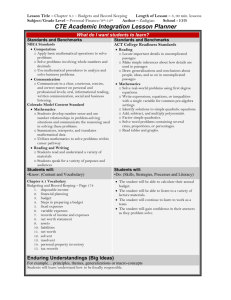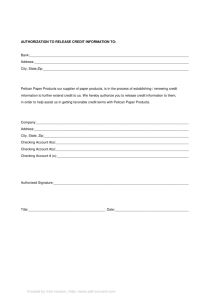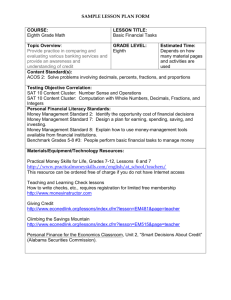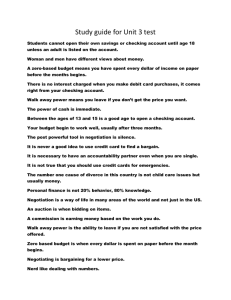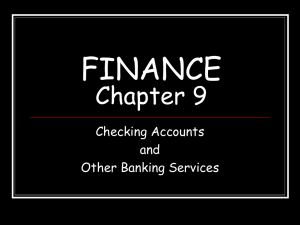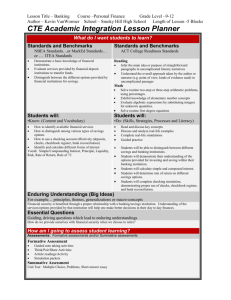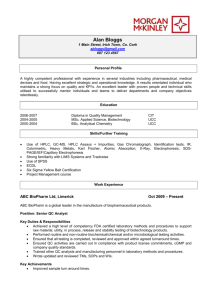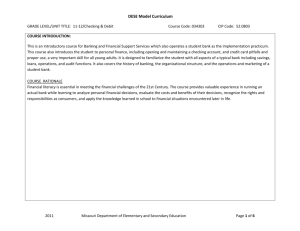CTE Academic Integration Lesson Planner
advertisement
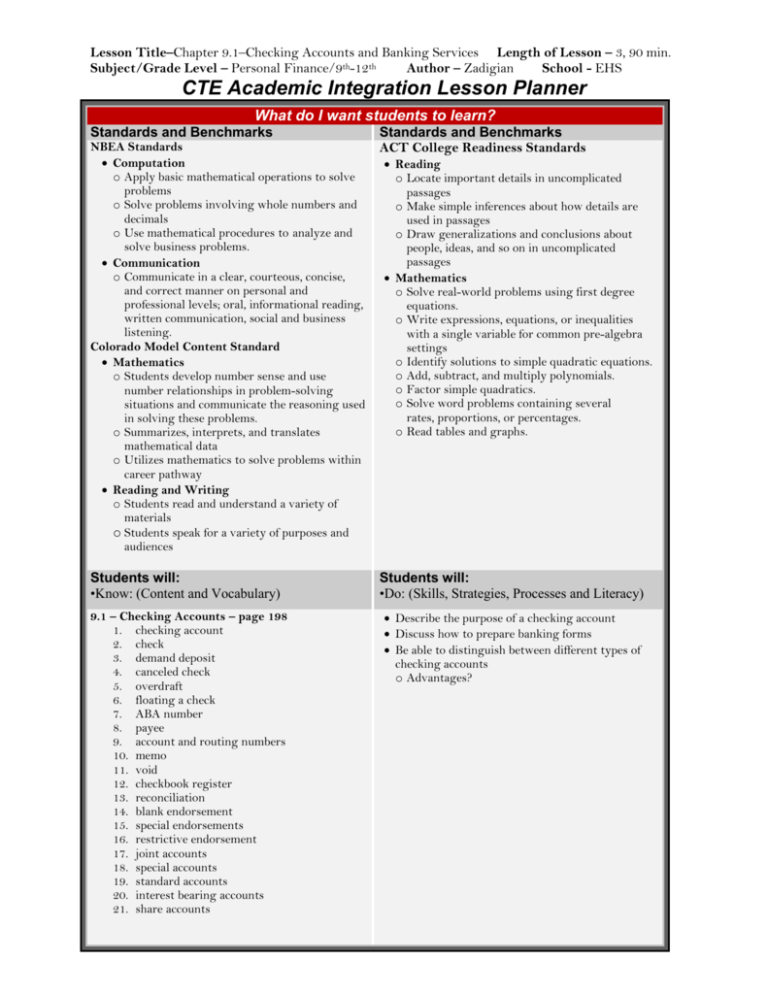
Lesson Title–Chapter 9.1–Checking Accounts and Banking Services Length of Lesson – 3, 90 min. Subject/Grade Level – Personal Finance/9th-12th Author – Zadigian School - EHS CTE Academic Integration Lesson Planner What do I want students to learn? Standards and Benchmarks NBEA Standards Computation o Apply basic mathematical operations to solve problems o Solve problems involving whole numbers and decimals o Use mathematical procedures to analyze and solve business problems. Communication o Communicate in a clear, courteous, concise, and correct manner on personal and professional levels; oral, informational reading, written communication, social and business listening. Colorado Model Content Standard Mathematics o Students develop number sense and use number relationships in problem-solving situations and communicate the reasoning used in solving these problems. o Summarizes, interprets, and translates mathematical data o Utilizes mathematics to solve problems within career pathway Reading and Writing o Students read and understand a variety of materials o Students speak for a variety of purposes and audiences Students will: •Know: (Content and Vocabulary) 9.1 – Checking Accounts – page 198 1. checking account 2. check 3. demand deposit 4. canceled check 5. overdraft 6. floating a check 7. ABA number 8. payee 9. account and routing numbers 10. memo 11. void 12. checkbook register 13. reconciliation 14. blank endorsement 15. special endorsements 16. restrictive endorsement 17. joint accounts 18. special accounts 19. standard accounts 20. interest bearing accounts 21. share accounts Standards and Benchmarks ACT College Readiness Standards Reading o Locate important details in uncomplicated passages o Make simple inferences about how details are used in passages o Draw generalizations and conclusions about people, ideas, and so on in uncomplicated passages Mathematics o Solve real-world problems using first degree equations. o Write expressions, equations, or inequalities with a single variable for common pre-algebra settings o Identify solutions to simple quadratic equations. o Add, subtract, and multiply polynomials. o Factor simple quadratics. o Solve word problems containing several rates, proportions, or percentages. o Read tables and graphs. Students will: •Do: (Skills, Strategies, Processes and Literacy) Describe the purpose of a checking account Discuss how to prepare banking forms Be able to distinguish between different types of checking accounts o Advantages? Lesson Title–Chapter 9.1–Checking Accounts and Banking Services Length of Lesson – 3, 90 min. Subject/Grade Level – Personal Finance/9th-12th Author – Zadigian School - EHS Enduring Understandings (Big Ideas) For example… principles, themes, generalizations or macro-concepts Students will learn/understand how to be fiscally responsible. Essential Questions Guiding, driving questions which lead to enduring understandings Describe the purpose of a checking account Discuss how to prepare banking forms Be able to distinguish between different types of checking accounts o Advantages? How am I going to assess student learning? Assessments: Formative assessments and/or Summative assessments Please see attached summative assessment Instructional Plan Prerequisite Skills: Preparation What prior knowledge, skills and understanding do the students need? How will you assess their background knowledge and readiness? At the beginning of every unit the students make flash cards of the vocabulary words from the textbook. This gives us a basis for discussion during the lecture and future assignments associated with the chapter. I also ask that they take those note cards home right away, that way they can be studying the vocabulary throughout the entire unit. They will then turn the note cards in on the day of the test and they are actually worth the same amount of points as the test. This shows students the importance of learning the vocabulary, as well as gives them a cushion in case they have difficulty on the exam. I will assess their background knowledge through various formative assessments and the questioning method throughout the lecture. Through the assignments I will also be able to see whether or not they understand the material presented. Instruction and Activities: What procedure (sequence), teaching strategies, and student activities are used in this lesson? State the student roles, teacher roles, and grouping for this lesson. Please see attached lesson plan Academic Integration What core academic topics are integrated? What terminology is common? What terminology is different? Include specific examples to be used to introduce, teach, or review the topics. Chapter 8.1 Content Describe the budgeting process and prepare personal budgets. Explain the purpose of record keeping and be able to prepare a personal net worth statement and a personal property inventory. Resources What materials and resources are needed for this lesson? Describe the learning environment where this lesson will take place. Materials and Resources Please see attached materials Managing your Personal Finances textbook Learning Environment Well, I have about 30 students (it changes all of the time) in this class, ranging from 9 th to 12th grade. This class has been one of my more difficult classes, for a couple of reasons. First, there are multiple different groups of friends within the class. I have a group of junior girls, senior boys, and freshman boys who all like to talk and associate with one another. I have done my best to switch the seating arrangements around when I see that something is not going to work, but somehow, at least a pair of students ends up sitting next to their friends and causing distractions. I honestly can not seem to find the right fit. I have tried to consequence them using participation points and I often have them work silently by themselves if they can’t handle working as a group or listening to me, but nothing has seemed to work. A few students have also had multiple visits to the Deans already this semester and a few have been suspended, making it difficult to get them caught up. I also have a few students with learning disabilities and a few pupil services students. For the most part, it is evident that these students are capable of doing the work, it is just a matter of doing it without getting distracted. Lesson Title–Chapter 9.1–Checking Accounts and Banking Services Length of Lesson – 3, 90 min. Subject/Grade Level – Personal Finance/9th-12th Author – Zadigian School - EHS By doing a variety of activities, expressing to them that the skills that they are learning and practicing will be extremely helpful to them in the “real world,” and having a little fun along the way, I am confident that I can keep the students engaged! Plus, the students are always enthusiastic when they get to dream big and be a little creative!!! I have also just found that if I have a positive attitude and am excited about the content, it has a powerful way of affecting the student’s attitude!
